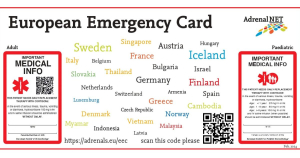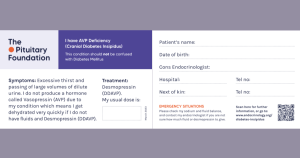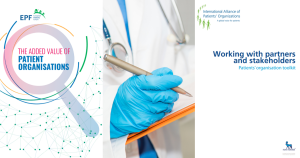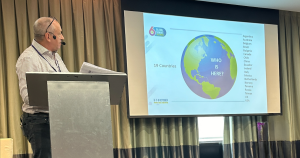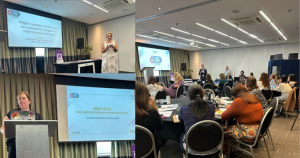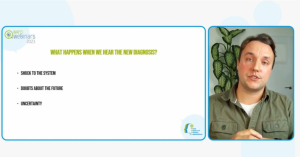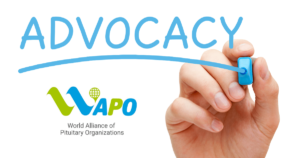2024 Blogs y Vlogs – Aspectos ocultos de los trastornos Hipofisarios al centro de las Campañas Camine con WAPO
Este año, WAPO ha creado dos campañas de sensibilización memorables para arrojar luz sobre los viajes de los pacientes con enfermedades hipofisarias raras. Camina con WAPO por el Mes de la Concienciación sobre la Pituitaria en octubre, y Camina con WAPO por el Día de Concienciación sobre la Acromegalia el 1º de noviembre, situaron las experiencias de los pacientes y el impacto invisible de estas afecciones en el centro de sus mensajes. Mediante una serie de infografías educativas y un vídeo protagonizado por personas que viven con acromegalia, buscamos concienciar y fomentar una mayor comprensión de la realidad de vivir con trastornos hipofisarios y los síntomas invisibles que los acompañan.

¿Qué es un síntoma invisible?
Los síntomas invisibles son síntomas físicos, mentales o neurológicos que no son inmediatamente visibles para los demás. En el contexto de un trastorno hipofisario, suelen referirse a la fatiga, el dolor, las dificultades cognitivas, los problemas de salud mental y los efectos de los desequilibrios hormonales que son difíciles de observar o comprender plenamente para los demás. Padecer una enfermedad con síntomas invisibles puede ser una experiencia solitaria y frustrante, ya que los profesionales sanitarios y otras personas de la vida personal o profesional pueden acusar al paciente de fingir o exagerar sus síntomas. Sin embargo, las personas que experimentan síntomas invisibles como parte de su enfermedad requieren atención psicosocial individualizada y adaptaciones para garantizar que puedan seguir participando, en la medida de sus posibilidades, en actividades escolares, laborales, sociales o domésticas. También merecen apoyo y empatía, no juicios ni estigmatización.
Camina con WAPO por el Mes de la Concienciación sobre la Pituitaria
Con motivo del Mes de la Concienciación sobre la Pituitaria, hemos creado cuatro infografías educativas, cada una de ellas publicada al comienzo de una nueva semana a lo largo de octubre. Cubrían las siguientes enfermedades raras: deficiencia de arginina-vasopresina (AVP) (también conocida como diabetes insípida central), enfermedad de Cushing, insuficiencia suprarrenal y acromegalia. La idea de estos pósters era recorrer el camino de un paciente, a través de sus síntomas iniciales, el proceso de diagnóstico, el tratamiento y el impacto a largo plazo de cada enfermedad. Previamente, también enviamos una encuesta para recoger citas de personas que viven con estas cuatro enfermedades, de modo que se pudieran amplificar sus voces y necesidades. Los participantes en la encuesta mencionaron a menudo síntomas invisibles, que se incluyeron en nuestra infografía para cada una de las cuatro enfermedades hipofisarias.
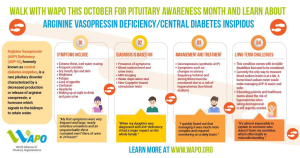
En cuanto a la deficiencia de AVP, un paciente dijo: “Mis primeros síntomas fueron micciones muy frecuentes y abundantes, casi incoloras, y una sed insaciable. Oriné más de 7 litros en 24 horas” Como puede imaginarse, la sed constante y la necesidad de orinar tienen un enorme impacto en la vida diaria del paciente.
En cuanto a la enfermedad de Cushing, los pacientes mencionaron cosas como “pensamientos incontrolados y confusión, niebla cerebral e insomnio“. La pérdida de memoria o los problemas de concentración pueden ser muy difíciles de entender para los pacientes y también para sus seres queridos.
Los pacientes con insuficiencia suprarrenal informaron de fatiga y náuseas graves, y uno de los encuestados declaró que “tuvo un gran impacto en mi vida, sobre todo por la fatiga“. Los bajos niveles de energía y la sensación de fatiga limitan la capacidad del paciente para participar en actividades que antes disfrutaba y debe aprender a darse tiempo para descansar y recuperarse.
Los pacientes con acromegalia mencionaron con frecuencia las cefaleas, la apnea del sueño y el dolor articular como síntomas de presentación. El dolor crónico puede ser debilitante y tener un impacto significativo en el sueño y el funcionamiento normal.
Muchos encuestados mencionaron la importancia de los grupos de apoyo o las organizaciones de pacientes. Uno dijo: “Los grupos de apoyo son un salvavidas. Saber que no estás solo y que puedes hablar de tus cosas con otras personas que entienden perfectamente por lo que has pasado puede hacerte sentir validado, permitirte regodearte cuando lo necesites y levantarte cuando estés listo para superar los momentos difíciles“.
Los carteles infográficos pueden verse y descargarse aquí:
- Deficiencia de AVP – 2024 WAPO Awareness – Deficiencia de Arginina VasoPressina – Diabetes Insípida
- Enfermedad de Cushing – 2024 WAPO Awareness – Enfermedad de Cushing
- Insuficiencia suprarrenal – 2024 WAPO Awareness – Insuficiencia suprarrenal – Enfermedad de Addison
- Acromegalia – 2024 WAPO Awareness – Acromegalia
Si desea que se traduzcan a su lengua local, póngase en contacto con WAPO para ver si ya existe una traducción.

Camina con la WAPO en el Día de Concienciación sobre la Acromegalia
“Los primeros síntomas y cambios que noté en mi salud con la acromegalia fueron dolores intensos, todas las noches, en manos y pies“- Mayulabis.
Para el día de concienciación sobre la acromegalia entrevistamos a nueve defensores de pacientes que respondieron a una serie de preguntas por vídeo. El vídeo recopilatorio resultante trataba temas como los primeros síntomas, el camino hasta el diagnóstico (a menudo muy largo), la gestión y el tratamiento, así como el impacto de la acromegalia en sus vidas y en las de su familia.
En este vídeo se mencionan muchos ejemplos de síntomas invisibles. Se corresponden con los resultados de un estudio de 2022 sobre el impacto psicosocial de vivir con afecciones hipofisarias, en el que se informaba de que los efectos físicos y cognitivos notificados con más frecuencia eran la fatiga, seguida del dolor y los trastornos del sueño. El dolor y la fatiga son subjetivos, lo que dificulta su comprensión y que se tomen en serio. Esto, junto con la falta de concienciación en la comunidad médica, puede ser una de las razones por las que los pacientes con acromegalia pueden esperar de 5 a 10 años desde el inicio de los síntomas hasta recibir su diagnóstico. Varios participantes mencionaron el cansancio y el dolor, como Donna, que dijo: “Si tuviera que utilizar una palabra para describir la acromegalia, probablemente sería agotador“.
El mismo estudio de 2022 señalaba los cambios de humor, la ansiedad y la depresión, así como la baja autoestima, los problemas emocionales y de comportamiento más comunes que experimentan los pacientes con afecciones hipofisarias. De hecho, escuchamos historias similares de los defensores de pacientes entrevistados, que decían cosas como “adquieres una nueva personalidad que no está a la altura de la anterior” y “física, mental y socialmente, te cambia el mundo“. También se mencionó la importancia de informar a los cuidadores y familiares de estos posibles cambios de personalidad, para evitar que se dañen relaciones importantes.
Vea aquí el vídeo completo del Día de Concienciación sobre la Acromegalia

Tenemos que hablar de todos los tipos de síntomas y gestionarlos
“Nunca preguntan. No preguntan: “¿Cómo estás?” Yo misma sentía, al principio, que la enfermedad era tabú” – Marie Louise
Cuando los pacientes se sienten incapaces de hablar de su enfermedad o sus síntomas con su familia, amigos y compañeros, esto puede tener un impacto negativo tanto en su salud mental como física. Los síntomas invisibles también pueden afectar la capacidad laboral del paciente, lo que puede afectar su seguridad económica. Un estudio de 2018 exploró la discapacidad laboral en pacientes con enfermedad relacionada con tumores hipofisarios, y descubrió que las demandas mentales y sociales del trabajo eran los problemas más comúnmente experimentados. Puede que los pacientes eviten hablar con sus jefes sobre su enfermedad por miedo a las repercusiones o a la estigmatización. Si se sienten incomprendidos por sus amigos y familiares, puede que se retiren de las actividades sociales y experimenten sentimientos de aislamiento, lo que puede ser perjudicial para su salud mental.
Por eso es tan importante contar con un sistema de apoyo y, a veces, esto puede significar encontrar a otras personas que están recorriendo el mismo camino o que viven con la misma enfermedad. Como Jeremie describe en el vídeo: “El apoyo de las personas que te rodean, como tu familia, tus amigos y tus seres queridos, dará definitivamente significado a tu viaje en la lucha contra esta enfermedad rara”. Contar con una sólida red de apoyo puede ayudar a mejorar la calidad de vida del paciente.
Esperamos que las campañas “Camina con WAPO ” tengan eco en muchas personas y contribuyan a mejorar la percepción y el apoyo de la sociedad a las personas con trastornos hipofisarios, tanto si sus síntomas son visibles como si no lo son.
Por favor, siga compartiendo estos recursos de WAPO durante las fiestas y el próximo año. El verdadero cambio requiere conversaciones abiertas en las que escuchemos a los demás e intentemos comprender sus necesidades particulares. También son necesarias adaptaciones en escuelas y lugares de trabajo, así como una mayor sensibilización entre los profesionales sanitarios y la comunidad en general. A la pregunta: “¿Qué le gustaría que supiera más gente sobre su enfermedad?“, uno de los encuestados respondió: “Me gustaría que supieran que vivir así es difícil en todos los aspectos de la vida, y que como sociedad podemos trabajar con más empatía para poder eliminar los estigmas sociales.”
Si le han gustado las campañas de sensibilización de WAPO de este año o tiene sugerencias para futuras iniciativas de WAPO, nos encantaría recibir sus comentarios.
Por último, queremos dar las gracias una vez más a los pacientes que participaron en estas campañas, tanto a los que compartieron sus historias en vídeo como a quienes aportaron citas para los pósters. Estamos muy agradecidos por su valentía y perspicacia, y son sus contribuciones las que han hecho que las campañas “Camina con WAPO” hayan sido un gran éxito.
Sigamos concienciando sobre los trastornos hipofisarios e inspirando el cambio hacia una sociedad más integradora y empática para todos.
Referencias:
https://hdsunflower.com/uk/insights/post/what-is-a-hidden-disability












